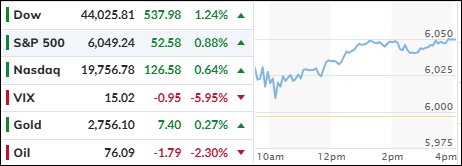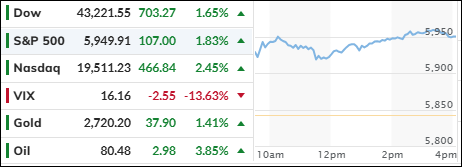
- Moving the market
The major indexes began the “post-inauguration” session with a positive outlook, as traders interpreted Trump’s comments on tariffs as less severe than initially anticipated.
Small Caps led the early surge, bolstered by a better-than-expected earnings report from 3M, which saw its stock rise by more than 4%.
Mega-tech companies like Amazon and Alphabet also contributed to the upswing. However, Apple, having faced two downgrades and now down 16% from its record highs, kept the Nasdaq from fully participating in the rally.
On Trump’s first day back in the Oval Office, unfair trade practices were a key focus. He issued a broad memorandum to Federal agencies to study the issue in more detail, easing Wall Street’s fears of an overly aggressive approach.
Gold rallied, reclaiming the $2,750 level, and erasing all post-election losses. Bitcoin, after bouncing off the $100k level, surged back above $107k, just shy of its record high of $109k.
Falling bond yields and a short squeeze provided the necessary momentum for today’s market rise, while the dollar initially bounced but faded by the close.
I couldn’t help but chuckle as oil prices declined throughout the session, with Trump’s famous adage “drill, baby, drill” dampening any bullish sentiment.
Read More



